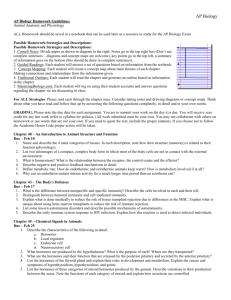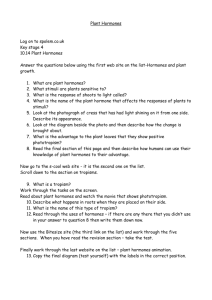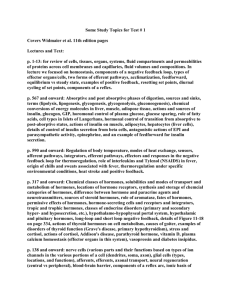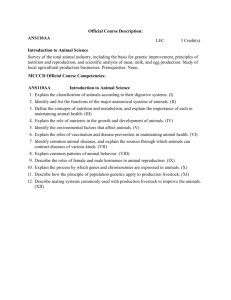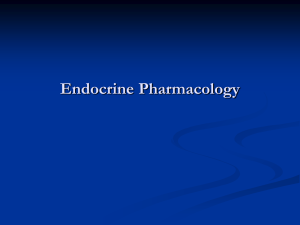The Theory of Plant Hormones - Agri
advertisement
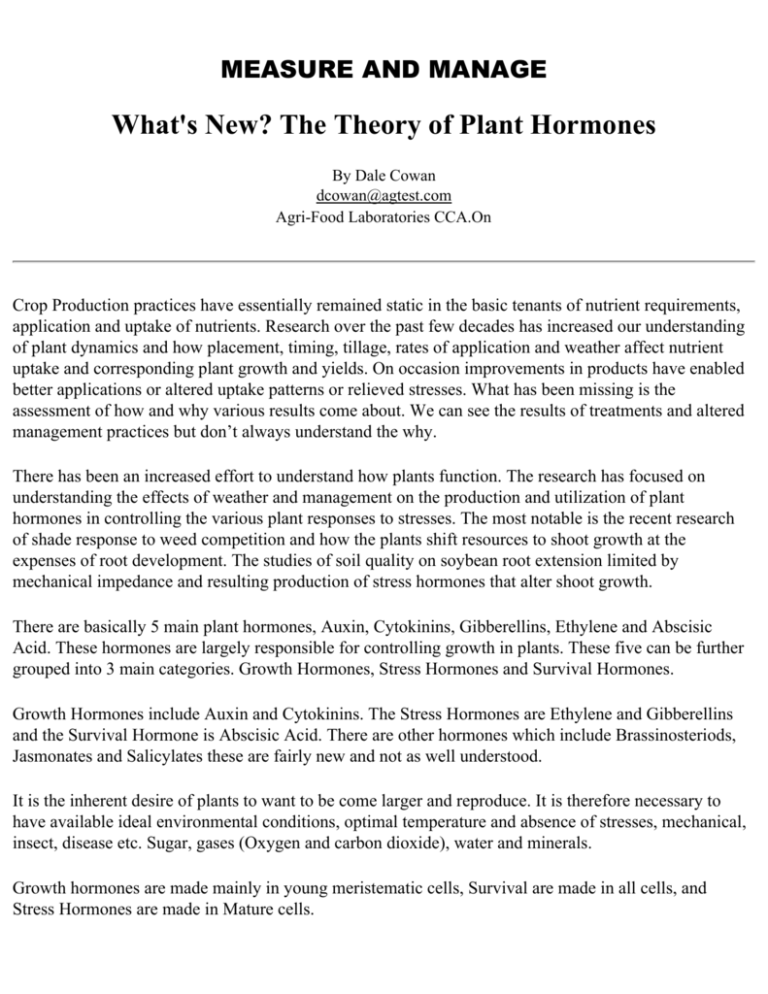
MEASURE AND MANAGE What's New? The Theory of Plant Hormones By Dale Cowan dcowan@agtest.com Agri-Food Laboratories CCA.On Crop Production practices have essentially remained static in the basic tenants of nutrient requirements, application and uptake of nutrients. Research over the past few decades has increased our understanding of plant dynamics and how placement, timing, tillage, rates of application and weather affect nutrient uptake and corresponding plant growth and yields. On occasion improvements in products have enabled better applications or altered uptake patterns or relieved stresses. What has been missing is the assessment of how and why various results come about. We can see the results of treatments and altered management practices but don’t always understand the why. There has been an increased effort to understand how plants function. The research has focused on understanding the effects of weather and management on the production and utilization of plant hormones in controlling the various plant responses to stresses. The most notable is the recent research of shade response to weed competition and how the plants shift resources to shoot growth at the expenses of root development. The studies of soil quality on soybean root extension limited by mechanical impedance and resulting production of stress hormones that alter shoot growth. There are basically 5 main plant hormones, Auxin, Cytokinins, Gibberellins, Ethylene and Abscisic Acid. These hormones are largely responsible for controlling growth in plants. These five can be further grouped into 3 main categories. Growth Hormones, Stress Hormones and Survival Hormones. Growth Hormones include Auxin and Cytokinins. The Stress Hormones are Ethylene and Gibberellins and the Survival Hormone is Abscisic Acid. There are other hormones which include Brassinosteriods, Jasmonates and Salicylates these are fairly new and not as well understood. It is the inherent desire of plants to want to be come larger and reproduce. It is therefore necessary to have available ideal environmental conditions, optimal temperature and absence of stresses, mechanical, insect, disease etc. Sugar, gases (Oxygen and carbon dioxide), water and minerals. Growth hormones are made mainly in young meristematic cells, Survival are made in all cells, and Stress Hormones are made in Mature cells. Growth Hormones The growth hormones are made when there is an excess of nutrients needed for survival. There are 5 basic processes involved First the hormones cause growth to take place. Second they initiate new growth, new shoots and roots Third they cause nutrient storage Fourth if the plant is using risky methods of obtaining nutrients it will switch to less risky methods. Five, the hormones will balance growth if there is excess sugar and gases it will cause the plant to stimulate new growth and balance out the growth process by encouraging more water and mineral uptake by the roots. The hormone Auxin is the main hormone involved in growth and will be initiated in any cell having an excess of Sugar and Gases needed for survival at peak activity. Stress Hormones The Stress Hormones are complimentary to the Growth Hormones. These are triggered when a plant has a nutrient deficiency. Again there are 5 basic functions initiated by these hormones. First they cause release of stored nutrients. Second they inhibit new growth. Third they cause senescence of older plant parts to release more nutrients and stop new growth thereby reducing demand for the nutrient in need and reducing the biomass requiring that nutrient thereby rebalancing the nutrient supply. Four, with less biomass needing growth these hormones now kick start and exaggerate the rate of growth to secure the nutrient supply. The most notable response is an increase in new root hair development. Five, the hormones change the nutrient gathering strategy to a more risky mode by increasing root surface area this will increase nutrient uptake and mineral adsorption but may make the plant more susceptible to water loss especially during a developing drought., disease or pest attack. The stress Hormones involve here are Ethylene for sensing water and mineral deficits and Gibberellins for sugar and gas deficit indicators Ethylene cause plant parts to senesce and Gibberellins cause root expansion. Survival Hormones These hormones are heavily influenced by environmental conditions more than Growth or Stress Hormones. The Survival Hormones modulate the Stress and Growth Hormones. Abscisic Acid (ABA) is the main Survival Hormone. ABA is an indicator of poor environmental conditions. As an example if the soil is very cold or the root is experiencing a compacted tight soil condition after a period of cold days and suddenly there is a change in the weather and a shot of sugar becomes available the growth of roots will not be very efficient due to cold soil and the normal amount of Auxin produced is low because of slow root expansion that sugar may be stored in the roots rather than used for expansion. This is modulated by ABA if the soil temperature was increased and root expansion occurred rapidly then ABA activity would lower and Auxins would be higher causing that sugar to be used for growth. There is a point where environmental conditions and nutrient supply are balance and no Survival Hormone is produced this would be a baseline level. As stresses are introduced such as cold soil, compaction or nutrient shortage then ABA would modulate and increase the stress hormones and when the nutrient supply and environmental conditions are rebalanced the growth hormones are re-established. This relationship can change throughout the day or in just short distances within a field or even within a row of plants. As we scout our fields and discover variability in growth it is usually a result of many factors. The question remains if I know and understand how hormones work can I enhance plant performance by adding additional hormones? The various stresses are manifested in many ways we are now just understanding how and why things happen this may very well lead us to better Management Practices or to Plant Hormone Therapy.


